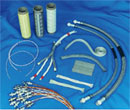Materials/Packages
Cavity Techniques for Substrate Properties at Microwave/Millimeter-wave Bands
For quality control in the design of microwave and millimeter-wave circuitry and devices, it is important to have a good measure of the dielectric properties of the materials employed. The standards and methods that are often employed for this purpose ...
Read More
A Deterministic Method for Optimizing VSWR
By using in conjuction both frequency and time domain reflection measurements, it is possible to positively identify the specific circuit discontinuities that contribute to a given VSWR lobe. Corrective action can then be readily determined for optimum...
Read More

